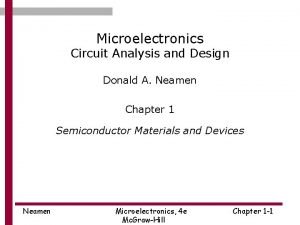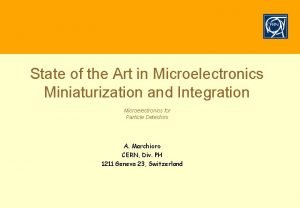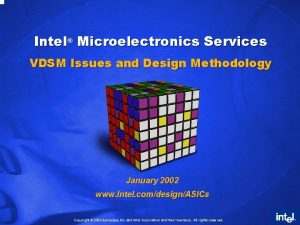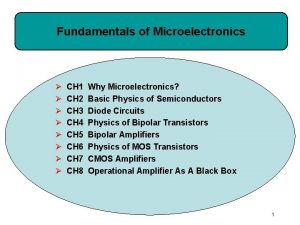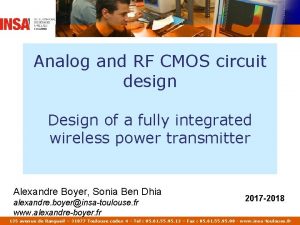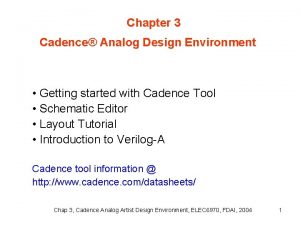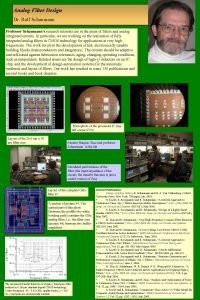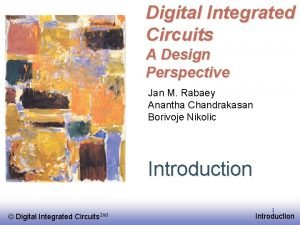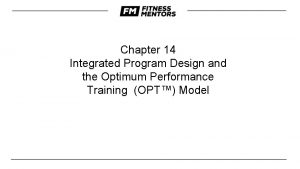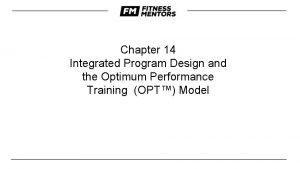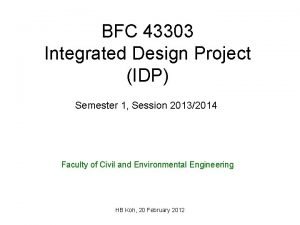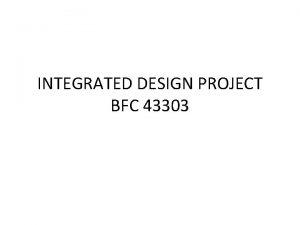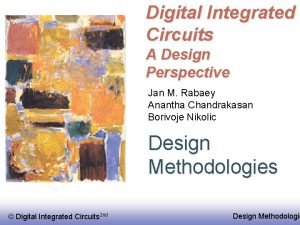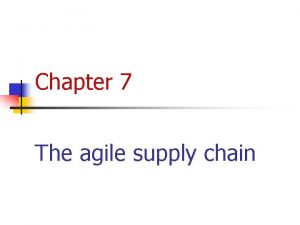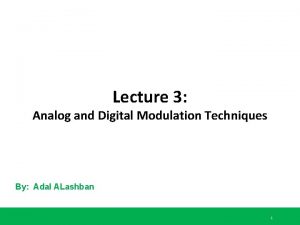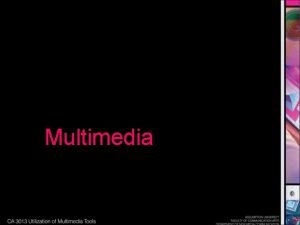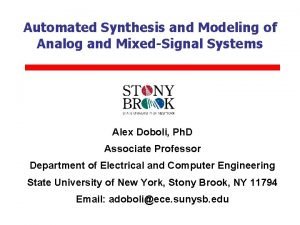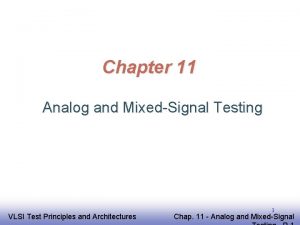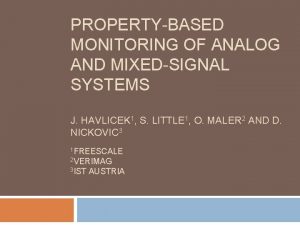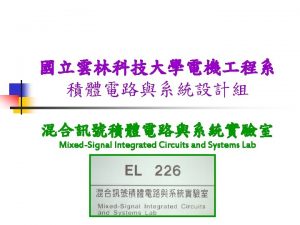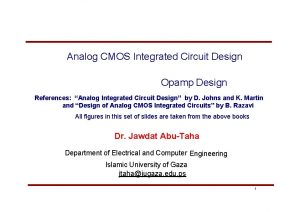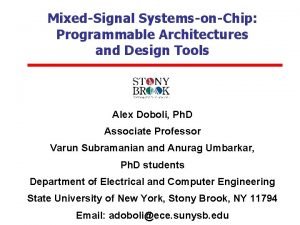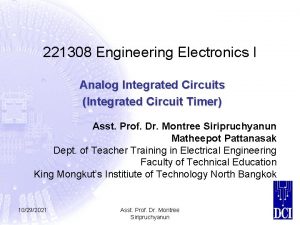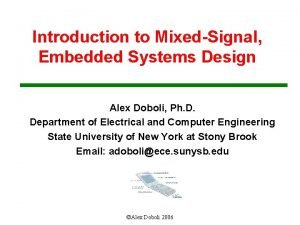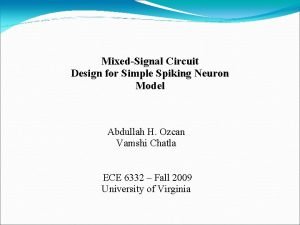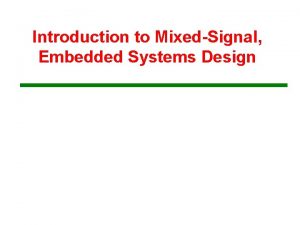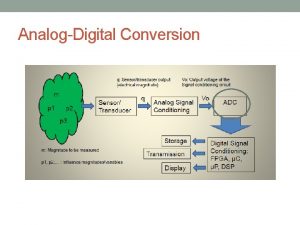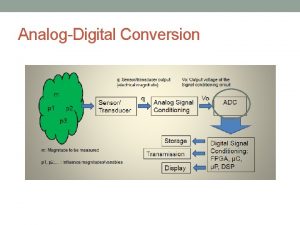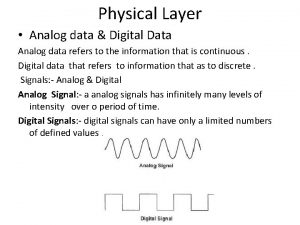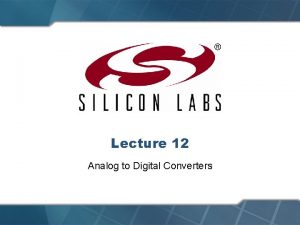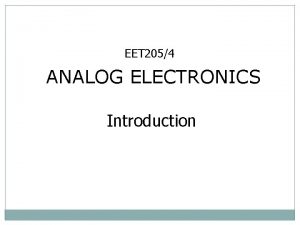Microelectronics III Design of integrated analog and mixedsignal











![Introduction in Analog Technology: P f [ W ] Hz -9 10 Process Development Introduction in Analog Technology: P f [ W ] Hz -9 10 Process Development](https://slidetodoc.com/presentation_image_h/02782c4229a5df554a0b9c3b54865684/image-12.jpg)
















- Slides: 28

Microelectronics III Design of integrated analog and mixed-signal CMOS-Circuits Chihao Xu 1

Advantages of digital circuit technology • Simple and faultless processing possible, so that large complexity can be managed. • Low requirements on variation in production Design Effort Analog Digital Complexity • Digital means discrete value (binary) and discrete time ! • High resolution is achieved by several bits (parallel) and clocks (sequential). 2

Why analog and mixed-signal? Interface-circuits • Amplification • Filtering • Modulation/Demodulation • Analog/Digital-Conversion • Digital/Analog-Conversion Signal processing • Simple functions • Quick feedback control Clock generator • Oscillator 3

Technical System Actuators Sensors l o r t A/D n Co D/A Logics Memory Analog Shell Processor / Algorithm Logics Programs I/O Interface Digital Core Human-Machine-Interface 4

Success Factors in Microelectronics Process CAD Design Analog 20% 10% 70% Digital 33% 33% Strength of European chip industry 5

Different operation region of analog vs. digital Analog technology Inverter characteristic Digital technology 6

Parameters to be considered in Analog Design 7

Bipolar Circuit Technology Bipolar-Process: only slow development Is used for - High frequency ICs (bipolar with Ge faster than CMOS) Application: Network-IC with Bi. CMOS - High blocking voltage (bipolar injection reduces voltage-drop) Application: Power electronics for high output power (Low volume compared with lower blocking voltage) - High precision Bipolar transistor is more robust (low variations in manufacturing, insensitive to mechanical stress etc. ). Application: Operational amplifier Bipolar technology is mainly for „niche“ applications. 8

Analog MOS-Circuit Technology Enormous synergy effects to digital technology (Process-Development) Simple Integration with digital circuits possible (e. g. as analog Frontend System on a Chip) High input impedance Frequency increases with newer process In modern processes the operating voltage gets lower. Fields of Circuit Technology - Analog-Digital-Converter (ADC) and Digital-Analog-Converter (DAC) - RF IC ( few GHz-range) - HV IC (< 100 V for Automobile, Display, Power Management, Industry etc. ) - Low Voltage Design - Low Power analog circuits Often 99% of transistors are digital and 1% analog. But this 1% makes the difference. 9

Content • Introduction into Analog Circuitry • CMOS Circuit Components Devices, inverter, source-follower, active load, current sources, cascode, differential stage • Operational Amplifier Structure , frequency compensation, optimal layout, characteristic parameters Mixed-Signal • Bandgap Reference • Switch-Capacitor-Technique • Analog/Digital-Converter • Digital/Analog-Converter • Phase Locked Loop (PLL) 10

References • B. Razavi, Design of Analog CMOS Intergated Circuits, Mc. Graw. Hill, 2001 • P. E. Allen and D. R. Holberg, CMOS Analog Circuit Design, Oxford University Press, 2002. • D. Johns, K. Martin, Analog Integrated Circuit Design, John Wiley & Sons, 1984, 1997 • P. R. Gray and R. G. Meyer, Analysis and Design of Analog Integrated Circuits, John Wiley & Sons, 1984. • U. Tietze, C. Schenk, Halbleiter Schaltungtechnik, Springer, 1990 11
![Introduction in Analog Technology P f W Hz 9 10 Process Development Introduction in Analog Technology: P f [ W ] Hz -9 10 Process Development](https://slidetodoc.com/presentation_image_h/02782c4229a5df554a0b9c3b54865684/image-12.jpg)
Introduction in Analog Technology: P f [ W ] Hz -9 10 Process Development -12 10 Power vs. Signal to Noise S/N -15 10 Analog -18 10 Digital S N 30 60 90 120 [d. B] 12

Comparison of Analog-Digital Analog: Digital: a: Activity factor • CMOS process optimized for digital circuits • CAD/EDA mainly for digital circuits • Complex algorithms possible • Insensitive to noise • High functional density --> small chip size • No truncation and limitation • Interfaces to real world 13

Dual Slope Converter for Digital-Voltmeter Uin Ui URef K Controller + Counter Clock Display DW Register 14

Typical Signal Processing Low Noise Amplifier Mixed-Signal Circuits Digital Circuits 15

Example: Architecture of a Digital Camera DA-Converter + Driver Sensor + Readout AD-Converter Signal. Processing Camera-Chip 16

Optical Distortion (Barrel-Effect) 17

Correction of Optical Distortion (Digital Image Processing) 18

Photo-Detector: Diode Al (contact) - UD + n+ Depletion p+ p-Sub 19

Quality features of a Photo-Detector Dark Current: if there is no light Temperature Noise Fixed Pattern Noise: non-uniformity for dark signals, but may get visible in photos. 20

Optical Characterization of Displays Display Photo-Detector Ampere meter Temperature Dark chamber 21

Readout Circuit of Photodiode (Pixel) exposure time Functions of readout circuit Light -> Current -> Charge -> Voltage 22

How are colors sensed ? Color filter: RGB 23

Pixel-Array A pixel consists of a sensor and the readout circuit. 24

Structure of a Digital Camera CFA: color filter array AGC: automatic gain control AD-Converter: low power, high speed Quality features: dark current dynamic range flexible, adapted dark bright 25

High dynamic range CMOS vs. CCD´s Multi-Integration Recalculated image of a 256 x 256 Pixel CMOS - image Sensor using 4 different integration times Conventional CCD sensor CMOS has a higher dynamic range (ca. 1000), while CCD just about 100 (analog). How can the details be displayed? Compression of contrast (digital)

High dynamic range CMOS vs. CCD´s Local Brightness-Adaptation 128 x 128 Pixel CMOS Sensor using a 9 x 9 rect - Filter Kernel 768 x 576 CCD sensor

Special Challenges for Digital Camera Pixel-Design -Photo-Detector Design -Sensitive Readout-Circuit Exposure in the darkness High contrast Furthermore: Low Power / fast ADConverter Analog Mixed-Signal Design is the key to success ! 28
 Temperature coefficient of resistance
Temperature coefficient of resistance Miniaturization of microelectronics
Miniaturization of microelectronics Defense microelectronics activity
Defense microelectronics activity Intel microelectronics
Intel microelectronics Fundamentals of microelectronics solution
Fundamentals of microelectronics solution Virginia microelectronics consortium
Virginia microelectronics consortium Microelectronics integrity meeting
Microelectronics integrity meeting Hamlet act iii scene iii
Hamlet act iii scene iii Device modeling for analog and rf cmos circuit design
Device modeling for analog and rf cmos circuit design Virtuoso analog design environment user guide
Virtuoso analog design environment user guide Analog design octagon
Analog design octagon Rolf schaumann
Rolf schaumann Razavi cmos analog circuit design
Razavi cmos analog circuit design Compare and contrast analog and digital forecasts
Compare and contrast analog and digital forecasts Compare and contrast analog and digital forecasting
Compare and contrast analog and digital forecasting Thematic unit examples
Thematic unit examples Jan m rabaey digital integrated circuits
Jan m rabaey digital integrated circuits Digital integrated circuits: a design perspective
Digital integrated circuits: a design perspective @nezupoi: title : she is working out chp.14
@nezupoi: title : she is working out chp.14 Integrated program design
Integrated program design Idp project for civil engineering
Idp project for civil engineering Integrated design project
Integrated design project Integrated design
Integrated design Digital integrated circuits a design perspective
Digital integrated circuits a design perspective Agile supply chain characteristics
Agile supply chain characteristics Digital to analog modulation techniques
Digital to analog modulation techniques Introduction to digital video
Introduction to digital video Analog and digital system difference
Analog and digital system difference Physical layer 1
Physical layer 1
